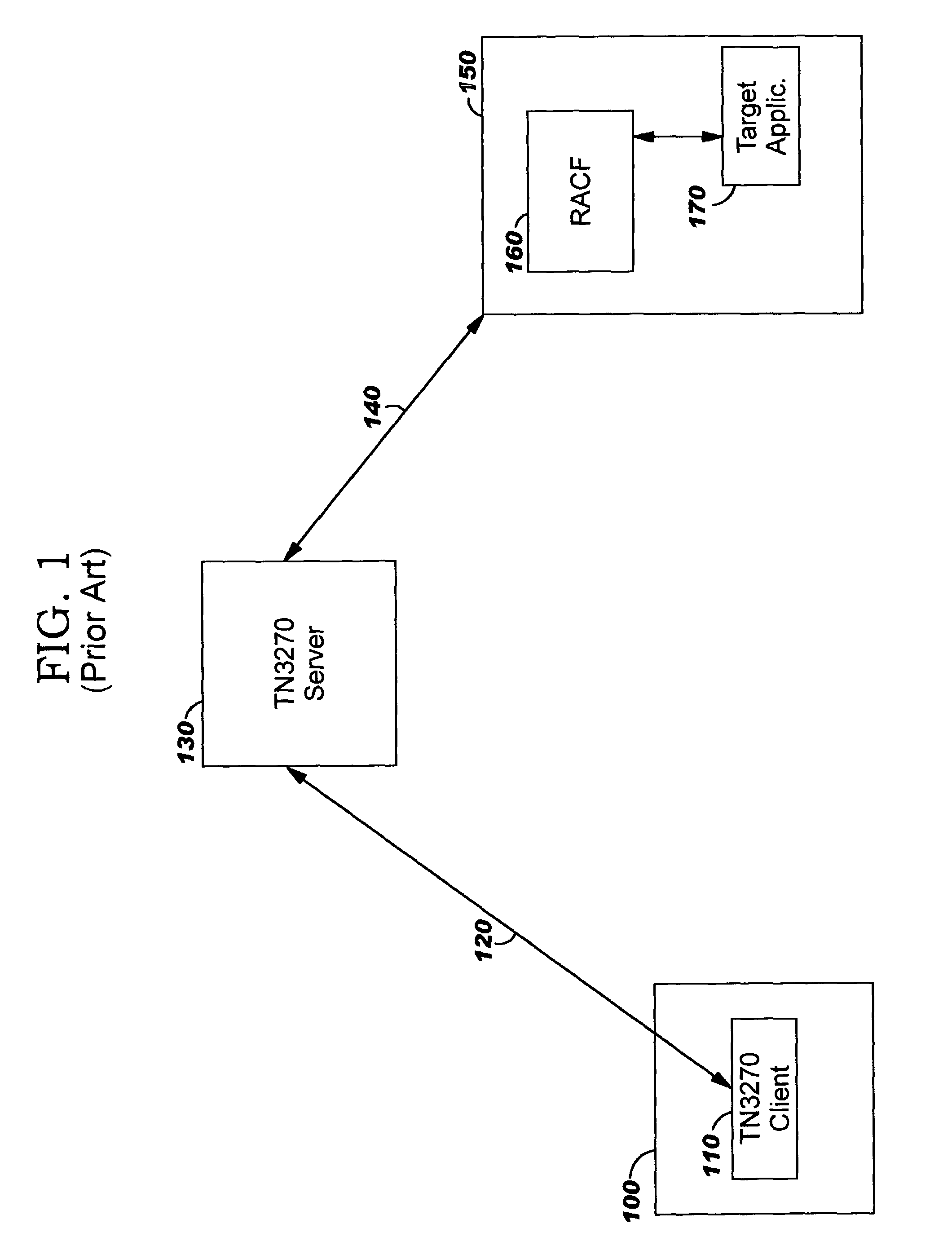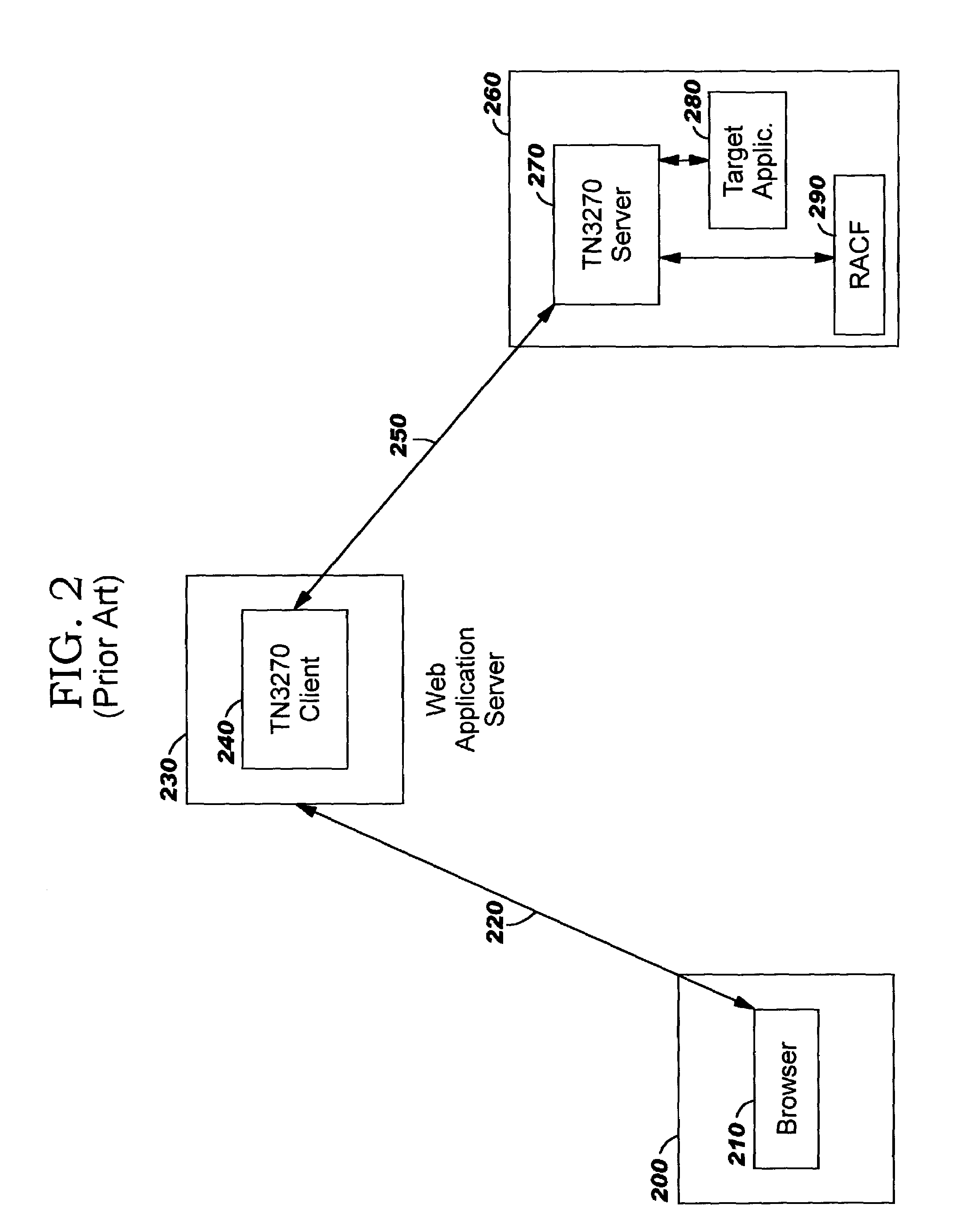Integrating legacy application/data access with single sign-on in a distributed computing environment
a distributed computing environment and legacy application technology, applied in the field of computer systems, can solve the problems of difficult integration of legacy mainframe host applications and data with modem computing environments and their modem user interfaces, inability to rewrite legacy applications in many situations, and inability to meet the needs of users, etc., to achieve convenient and secure access.
- Summary
- Abstract
- Description
- Claims
- Application Information
AI Technical Summary
Benefits of technology
Problems solved by technology
Method used
Image
Examples
first preferred embodiment
[0070]A first preferred embodiment, shown in FIG. 3, may be used when access manager agent software 325 operating on the Web application server 320 understands how to request passtickets from a legacy host access agent. A user working in a Web environment typically signs on to a Web site using an access manager agent by establishing a connection 315 from his browser 300 to a Web application server 320, and then using the browser to navigate to an initial sign-on Web page (such as a portal page 1100 shown in FIG. 11) where he provides his user ID and password. Using the provided user ID and password, the access manager agent can authenticate the user.
[0071]According to preferred embodiments, to enable the user to seamlessly access legacy applications, the initial sign-on Web page (or a subsequent page, alternatively) preferably provides an icon or hyperlink with which the user can select legacy application access. Suppose, for example, that the portal page 1100 of FIG. 11 is used as ...
second preferred embodiment
[0103]In a second preferred embodiment, the access manager agent is not adapted for requesting passtickets from a host access agent. Accordingly, server-side code such as a servlet and a credential mapper function are used to handle the passticket request. This embodiment will be described with reference to the components illustrated in FIG. 13. (It should be noted that many features described with reference to the first preferred embodiment apply equally to this embodiment, such as establishing a secure session with a Web application server, receiving a Web page from which a legacy application can be selected, use of macros, and so forth. Accordingly, this description of the second preferred embodiment will not repeat the details of that information. Furthermore, the third through sixth embodiments share many of these same features, and discussions thereof will therefore focus on differences. For ease of reference, subsequent discussions do not distinguish between legacy access cod...
third preferred embodiment
[0111]In a third preferred embodiment, useful where passticket capability is not available, the user's credentials are retrieved from a “lockbox” (i.e., secure storage) accessible by the Web application server with which the client has established a secure session. This embodiment will be described with reference to the components in FIG. 14.
[0112]As in the first and second embodiments, browser 1400 establishes a secure session 1415 to Web application server 1420, and access manager 1425 authenticates the user with his user ID and password (or similar identifying information). When the user requests to access a legacy application, the browser sends an HTTP request, which reaches the access manager. In response, the access manager retrieves the user's ID from the security token, and sends this user ID and the ID of the selected application (or of each potential application, as described with reference to the second aspect of the first preferred embodiment) over a secure, trusted conn...
PUM
 Login to View More
Login to View More Abstract
Description
Claims
Application Information
 Login to View More
Login to View More - R&D
- Intellectual Property
- Life Sciences
- Materials
- Tech Scout
- Unparalleled Data Quality
- Higher Quality Content
- 60% Fewer Hallucinations
Browse by: Latest US Patents, China's latest patents, Technical Efficacy Thesaurus, Application Domain, Technology Topic, Popular Technical Reports.
© 2025 PatSnap. All rights reserved.Legal|Privacy policy|Modern Slavery Act Transparency Statement|Sitemap|About US| Contact US: help@patsnap.com



